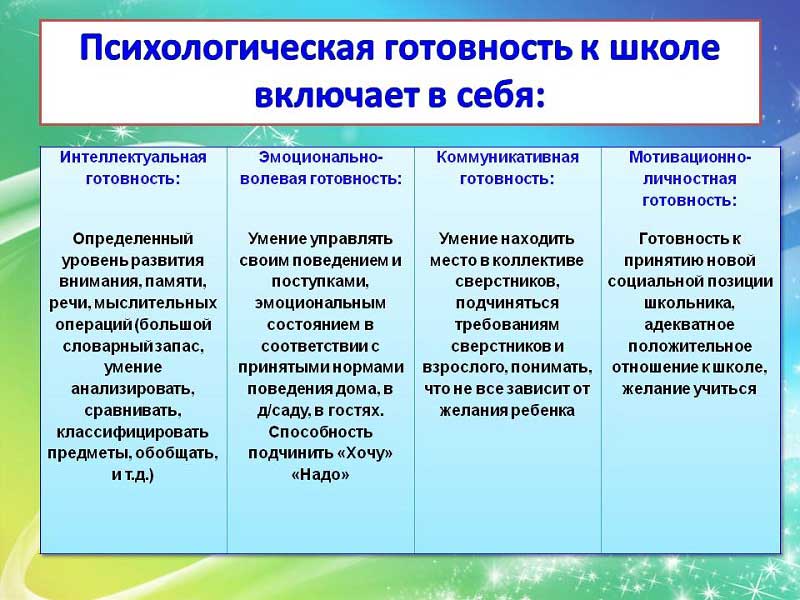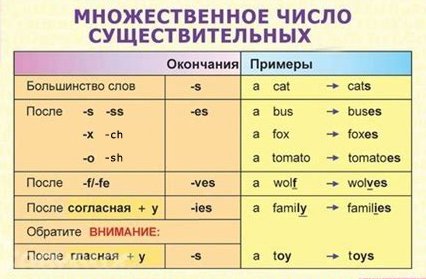Readiness for school is the degree of formation of certain qualities of a child for successful learning at school. Preparation for school is a set of activities aimed at forming the child’s readiness for learning at school. First of all, readiness for school includes 3 large blocks: knowledge, general awareness of a 6-7 year old child entering school, psychological readiness for school, level of physical health.

When entering school, a child must have the following knowledge, skills and ideas.
Speech development:
– be able to name an object, an object’s feature, and an object’s action;
– be able to highlight several features of objects, an object’s action, or actions with an object;
– compose sentences from 3-4 given words;
– form new phrases (fur hat – fur hat, etc.);
– be able to give a brief description of objects and phenomena (red fox, lives in the forest, predatory animal);
– independently compose a coherent story of at least 6-7 sentences (including from pictures and personal experience);
– retell short stories;
– know and expressively recite poems;
– use words correctly in speech;
– use antonyms in speech (words with opposite meanings, for example: wide – narrow, dark – light, etc.);
– guess riddles, explain the meaning of proverbs, understand figurative expressions.
– be able to continue a sentence or phrase according to the meaning.
Literacy, reading:
– know and be able to write printed letters of the Russian alphabet;
– be able to distinguish sounds from letters, pronounce sounds and letters correctly;
– determine the number of syllables in words;
– be able to distinguish between the concepts of sound, letter, syllable, word, sentence, text;
– determine the number of sounds in words, the place of a sound in a word, be able to distinguish sounds from words;
– be able to put stress in words, find the stressed vowel sound in a word and the stressed syllable;
– know consonants and vowel sounds;
– know the features by which vowels (stressed and unstressed) and consonant sounds (soft-hard, voiceless voiced) differ;
– be able to analyze the sound composition of a word (differentiate sounds in a word: vowel-consonant, stressed vowel-unstressed, consonant: soft-hard, voiceless-voiced – and mark them with red, green and blue chips; be able to determine the number of letters and sounds in words; know that the vowels ya, e, yo, yu denote 2 sounds if they are at the beginning of a word, after a vowel or after the separating signs ъ and ь);
– know that consonants can be paired and unpaired; always hard consonants: zh, sh, ts, always soft consonants: y, ch, shch; vowels a, o, u, y, e denote the hardness of consonants;
– be able to make a syllabic diagram of a word and a sentence diagram;
– know how exclamatory, interrogative and declarative sentences are pronounced intonationally; accordingly, know punctuation marks;
– be able to read (at least by syllables, preferably at least 25 words per minute).
Mathematics:
– be able to count from 1 to 20 and back, restore a numerical series in which some numbers are missing;
– be able to find neighbors of numbers within 10-20;
– perform counting operations within ten, increase/decrease the number of objects “by one”, “by two”;
– know the concepts of “more-less-equally”;
– be able to make unequal groups of objects equal by decreasing or increasing one of the groups;
– know simple geometric figures, be able to make appliques from geometric figures;
– be able to compare objects by length, width and height;
– be able to divide an object (circle, square) into two/three/four equal parts;
– be able to write in printed numbers;
– be able to correlate the graphic image of a number with the number of objects;
– know and be able to use the signs “+, –, =”, “<,>”;
– be able to solve problems on addition and subtraction within 10;
– understand what numbers all numbers from 1 to 10 consist of (the composition of numbers within 10).
Desirable:
– be able to count to 100 in units and tens;
– understand what numbers form two-digit numbers of the second ten and the remaining two-digit numbers within 100;
– be able to compare sets, distinguish a set from its parts;
– be able to use a ruler (measure the sides of geometric figures, draw a segment of a given length).
The world around us:
– know the name of your city, region, country, capital of the country, president, flag of the country;
– know the name of our planet;
– know the names of the main professions, explain what is characteristic of these professions;
– name the seasons, parts of the day, days of the week in sequence;
– know the seasons and months in sequence;
– distinguish predatory animals from herbivores, domestic from wild ones, know and distinguish the inhabitants of the forest, desert, reservoirs;
– be able to correctly name animals and their babies (sheep – lamb, horse – foal, cow – calf, dog – puppy, etc.);
– know and distinguish migratory birds from wintering birds;
– distinguish garden trees from field trees;
– distinguish trees from bushes;
– distinguish garden trees from field trees;
– distinguish trees from bushes;
– name different natural phenomena;
– be able to tell time on a clock;
– be able to distinguish the concepts: century, year, month, season, day of the week, time of day, date; be able to use a calendar;
– know the types of transport.
Hand and writing skills:
– hold a pen and pencil correctly in your hand;
– draw continuous straight, wavy, broken lines;
– trace a drawing along the contour without lifting the pencil from the paper;
– be able to draw by cells and dots;
– be able to finish drawing the missing half of a symmetrical drawing;
– copy from a sample and independently draw geometric figures;
– be able to continue shading a drawing;
– be able to write printed letters and numbers
– be able to cut along the contour, use scissors.
General ideas:
– know your full name and the full name of your parents, be able to tell where and by whom your parents work;
– know your exact address;
– know your date of birth, what time of year you were born;
– be able to distinguish and name the main colors (it is desirable to know the sequence of colors in the rainbow and know what colors form shades of colors);
– know the concept and be able to determine right-left, top-bottom, behind, above, in front of, after, near, in, etc.;
– be able to navigate on a sheet of paper and a square (upper right, lower left corner, etc.);
– know the basic rules of etiquette (say hello, say goodbye, be able to ask, request, thank, address adults as “You”, etc.);
– know the basic rules of the road.
Ideas about school:
– to know when the child will go to school (what time of year and date);
– to know why the child needs to go to school, what they do at school;
– to know how old the child will be when he or she enters school;
– to know the basic school supplies and be able to explain what they are for;
– to know the concepts of teacher, student, lesson, recess, bell;
– to know the rules of conduct at school.
Psychological readiness for school.
L.A. Venger, a Soviet psychologist and doctor of psychological sciences, once said: “Being ready for school does not mean being able to read, count and write. Being ready for school means being ready to learn all of this.” In a sense, psychological readiness for school is the ability to learn.
Cognitive readiness:
– general intellectual readiness, developed memory (describe a picture from memory, memorize 8-10 simple pictures out of 10, 8-10 words out of 10, memorize a sentence of 5 words and repeat it), perception (perceive and notice objects in full and their parts, details), attention (concentrate on a task for at least 15 minutes, find 10 differences in pictures, copy a pattern or movement exactly), thinking, logic (find and explain inconsistencies in pictures, find and explain differences and similarities between objects, find an extra object and classify by a common feature, be able to compare objects, find patterns. Assemble a figure from a construction set according to a sample, assemble puzzles independently, draw analogies, restore the sequence of events), speech (see information above), imagination;
– developed phonemic hearing (necessary for a child to write correctly at school, without mistakes, not skip letters in words);
– developed gross and fine motor skills, general psychomotor development of the child.
Personal readiness:
– motivation (developed cognitive interest in learning);
– self-esteem (positive self-image and ability to survive failure).
– emotional development (ability to express, control one’s emotions, ability to read emotions of other people);
– internal position of the student (understands his new social status and that he goes to school to study, not to play).
Willpower:
– arbitrariness of behavior, self-regulation (the child understands that he will need to complete various tasks at school – interesting and not so attractive; subordinates his impulsive desires to the need to study);
– arbitrariness of mental functions (directs attention not only to what attracted him, but also to what the educational process and the teacher require of him; is ready to remember the necessary information, and not just what attracted his attention, etc.);
– goal-setting, the ability to achieve results, the ability to control the process, conduct a check and verify the result for correctness.
Communicative component of school readiness:
– ability to interact, cooperate with adults (listen, address, ask; beware of strange adults on the street);
– ability to communicate with peers (in pairs, groups; ability to get acquainted, easily establish contact, ability to invite to play, ability to resolve conflict situations, ability to defend one’s boundaries without conflict and not violate others’, take into account one’s interests and the interests of the group, ability to negotiate);
– ability to listen to the interlocutor;
– ability to express one’s thoughts and one’s point of view. If a child is not psychologically ready for school, then the chances of successful and easy learning are significantly reduced.
Preparatory classes for school are necessary if:
– the child did not attend kindergarten;
– you notice and have an assumption that one of the above components or sub-items is not sufficiently formed in the child (since there are many children in groups at the kindergarten and teachers often fail to pay attention to each child);
– your child has undergone diagnostics of readiness for school and it turned out that the child needs additional preparatory classes;
– your child has difficulties and difficulties in mastering cognitive material; has low attention span, small memory capacity, difficulty memorizing stories and difficulty retelling, etc.);
– the child’s speech is insufficiently developed;
– the child has difficulty communicating (with parents, adults, peers);
– the child has poorly developed volitional and personal components (often disobeys, has no desire to study, does not want to go to school in a year, low self-esteem, does not know how to cope with failures, does not know how to achieve results and goals);
– the child has experienced psychological trauma(s), is in a state of stress (this affects mental activity, communication and, in general, the desire to learn),
– the child has suffered injuries or operations on the brain,
– has neurological diseases, MBD (minimal brain dysfunction), symptoms of hyperactivity, mental retardation.






